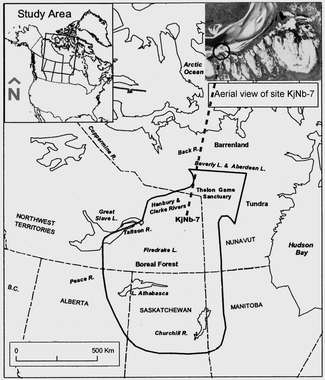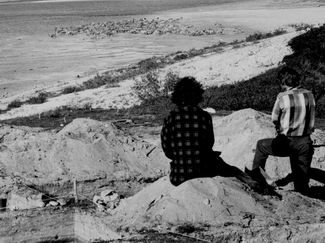That tasks overlap through repeated use by hunters over millennia, with specific tasks over the same spots, is understandable in constricted caves, canyons and ridgetops, but this study documents that prolonged overlap also occurs in open sites. Containment was not restricted by terrain but by social interaction. Tasks occurred in this northeast-constricted wind-exposed bluff overlooking the river because it was an overlook where the autumn-migrating herd could be seen approaching the crossing from 6-8 km northeast, allowing a half-hour to vacate the overlook and intercept the herd as it crossed the Thelon River. The wind-exposed bluff also provided relative freedom from blood-sucking and biting insects during summer while people were engaged in tasks that required the use of both hands.
After plotting the remaining tasks of roasting, marrow extraction and woodworking, I found not only that all overlap in each palimpsest in each archaeological level, but repeat in all three palimpsests in three separate levels. I also found all were confined (12 x 16 m) to the northeast end of KjNb-7 nearest the river. The KjNb-7 caribou water-crossing camp is in the north part of the Beverly caribou range which extended from the Churchill River in northern Saskatchewan through the Thelon Game Sanctuary to the population’s calving grounds north of Beverly and Aberdeen lakes (Fig. 1a).

Figure 1a. Study Area in north-central mainland Canada
Hunting families moved seasonally across the range, intercepting herd migrations. The Beverly herd migrated from its southern forested range to its summer calving grounds to the north, then back and forth across the rivers throughout the summer into autumn, and finally south once more on the water-crossings. Before continuing south to winter locations below treeline, it was intercepted at water-crossings, as seen in the aerial and ground photographs (Fig. 1b).

Figure 1b. KjNb-7 Herd Confirmation
Based on Hearne’s 1770-2 ethnographic accounts and my records of herd movement, tundra sites were occupied by hunters for several weeks, while treeline and forest sites were often occupied for most of the year as people prepared for winter (Hearne 1958). Of the Beverly range’s 1002 camps that I recorded, mid-July-occupied tundra site KjNb-7 has the most complex palimpsests because both sexes and all ages of caribou and regional Chipewyan hunting bands were at their largest at this northernmost crossing.
KjNb-7 is above the south shore of the Thelon River, opposite a huge V-shaped sand blowout (Fig.1a, inset right, circled). Satellite sites, also used in July when the herd did not cross directly to KjNb-7, are scattered east along an arc-like series of downriver sand blowouts. After the hunt, carcass gutting and quartering were accomplished on the shore away from camp, where offal most likely was thrown in the river to leave less to attract unwanted grizzlies (Ursus horribilis) and wolves.